Two charge conceptric spherical shell have radii 10.0cm and 15.0cm. The charge on the inner shell is 7.50×10−8C, and that on the outer shell is 6.33×10−8C. Find the electric field (a) at r=12.0cmand(b)atr=20.0 cm.
To solve the problem of finding the electric field at two different points due to two concentric spherical shells with given charges, we will use Gauss's Law.
Given Data:
- Radius of inner shell, R1=10.0cm=0.1m
- Radius of outer shell, R2=15.0cm=0.15m
- Charge on inner shell, Q1=7.50×10−8C
- Charge on outer shell, Q2=6.33×10−8C
(a) Electric Field at r=12.0cm
1. Identify the region:
- The point r=12.0cm is between the inner shell (10.0 cm) and the outer shell (15.0 cm).
2. Apply Gauss's Law:
- Gauss's Law states that the electric flux through a closed surface is equal to the charge enclosed divided by the permittivity of free space:
ΦE=Qencϵ0
- The electric flux ΦE can also be expressed as:
ΦE=E⋅A
where A is the surface area of the Gaussian surface.
3. Choose a Gaussian surface:
- We choose a spherical Gaussian surface of radius r=12.0cm.
- The surface area A of the Gaussian surface is:
A=4πr2=4π(0.12)2=4π(0.0144)≈0.18096m2
4. Determine the charge enclosed:
- Only the charge on the inner shell Q1 is enclosed:
Qenc=Q1=7.50×10−8C
5. Set up the equation:
E⋅A=Qencϵ0
E⋅(0.18096)=7.50×10−88.85×10−12
6. Calculate the electric field E:
E=7.50×10−88.85×10−12⋅0.18096
E≈7.50×10−81.600×10−12≈4.68×104N/C
(b) Electric Field at r=20.0cm
1. Identify the region:
- The point r=20.0cm is outside both shells.
2. Apply Gauss's Law:
- The total charge enclosed by a Gaussian surface at r=20.0cm includes both shells:
Qenc=Q1+Q2=7.50×10−8+6.33×10−8=1.383×10−7C
3. Choose a Gaussian surface:
- The surface area A of the Gaussian surface is:
A=4π(0.20)2=4π(0.04)≈0.50265m2
4. Set up the equation:
E⋅A=Qencϵ0
E⋅(0.50265)=1.383×10−78.85×10−12
5. Calculate the electric field E:
E=1.383×10−78.85×10−12⋅0.50265
E≈1.383×10−74.45×10−12≈3.1×104N/C
Summary of Results:
- (a) Electric field at r=12.0cm: E≈4.68×104N/C
- (b) Electric field at r=20.0cm: E≈3.1×104N/C
- Radius of inner shell, R1=10.0cm=0.1m
- Radius of outer shell, R2=15.0cm=0.15m
- Charge on inner shell, Q1=7.50×10−8C
- Charge on outer shell, Q2=6.33×10−8C
- The point r=12.0cm is between the inner shell (10.0 cm) and the outer shell (15.0 cm).
- Gauss's Law states that the electric flux through a closed surface is equal to the charge enclosed divided by the permittivity of free space:
ΦE=Qencϵ0
- The electric flux ΦE can also be expressed as:
ΦE=E⋅A
where A is the surface area of the Gaussian surface.
- We choose a spherical Gaussian surface of radius r=12.0cm.
- The surface area A of the Gaussian surface is:
A=4πr2=4π(0.12)2=4π(0.0144)≈0.18096m2
- Only the charge on the inner shell Q1 is enclosed:
Qenc=Q1=7.50×10−8C
E⋅A=Qencϵ0
E⋅(0.18096)=7.50×10−88.85×10−12
E=7.50×10−88.85×10−12⋅0.18096
E≈7.50×10−81.600×10−12≈4.68×104N/C
- The point r=20.0cm is outside both shells.
- The total charge enclosed by a Gaussian surface at r=20.0cm includes both shells:
Qenc=Q1+Q2=7.50×10−8+6.33×10−8=1.383×10−7C
- The surface area A of the Gaussian surface is:
A=4π(0.20)2=4π(0.04)≈0.50265m2
E⋅A=Qencϵ0
E⋅(0.50265)=1.383×10−78.85×10−12
E=1.383×10−78.85×10−12⋅0.50265
E≈1.383×10−74.45×10−12≈3.1×104N/C
- (a) Electric field at r=12.0cm: E≈4.68×104N/C
- (b) Electric field at r=20.0cm: E≈3.1×104N/C
Topper's Solved these Questions
- BOOK - RESNICK AND HALLIDAYCHAPTER - GAUSS' LAW EXERCISE - PRACTICE QUESTIONS (SINGLE CORRECT CHOICE TYPE)20videos
GAUSS' LAW
- BOOK - RESNICK AND HALLIDAYCHAPTER - GAUSS' LAW EXERCISE - PRACTICE QUESTIONS (MORE THAN ONE CORRECT CHOICE TYPE)2videos
GAUSS' LAW
- BOOK - RESNICK AND HALLIDAYCHAPTER - GAUSS' LAW EXERCISE - CHECKPOINT7videos
GAUSS' LAW
- BOOK - RESNICK AND HALLIDAYCHAPTER - FORCE AND MOTION-IIEXERCISE - PRACTICE QUESTIONS (Integer Type)1videos
FORCE AND MOTION-II
- BOOK - RESNICK AND HALLIDAYCHAPTER - GEOMETRICAL OPTICS : REFLECTION EXERCISE - PRACTICE QUESTIONS (Integer Type)3videos
GEOMETRICAL OPTICS : REFLECTION
Similar Questions
There are two concentric conducting spherical shells of radii 10 cm and 20 cm. The outer shell is charged to a potential of 50esu while inner shell is earthed. The charge on outer shell is
View SolutionConsider two concentric spherical metal shells of radii r1 and r2(r2>r1). Find the charge on the inner shell and charge distribution.
View Solution
Knowledge Check
- Question 1 - Select One
There are two concentric spherical shell of radii r and 2r. Initially, a charge Q is given to the inner shell and both the switches are open.
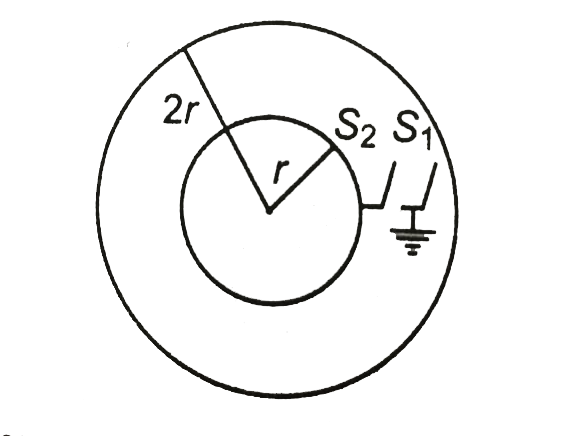
If switch S1 is closed and then opened, charge on the outer shell will beAQBQ/2C−QD−Q/2 - Question 2 - Select One
A small conducting spherical shell with inner radius a and outer radius b is concentric with a larger conducting spherical shell with inner radius c and outer radius d ( as shown in Fig . 2.121). The inner shell has a total charge +2q, and the outer shell has a total charge +4q. Calculate the electric field in terms of q and the distance r from the common center of the two shells for
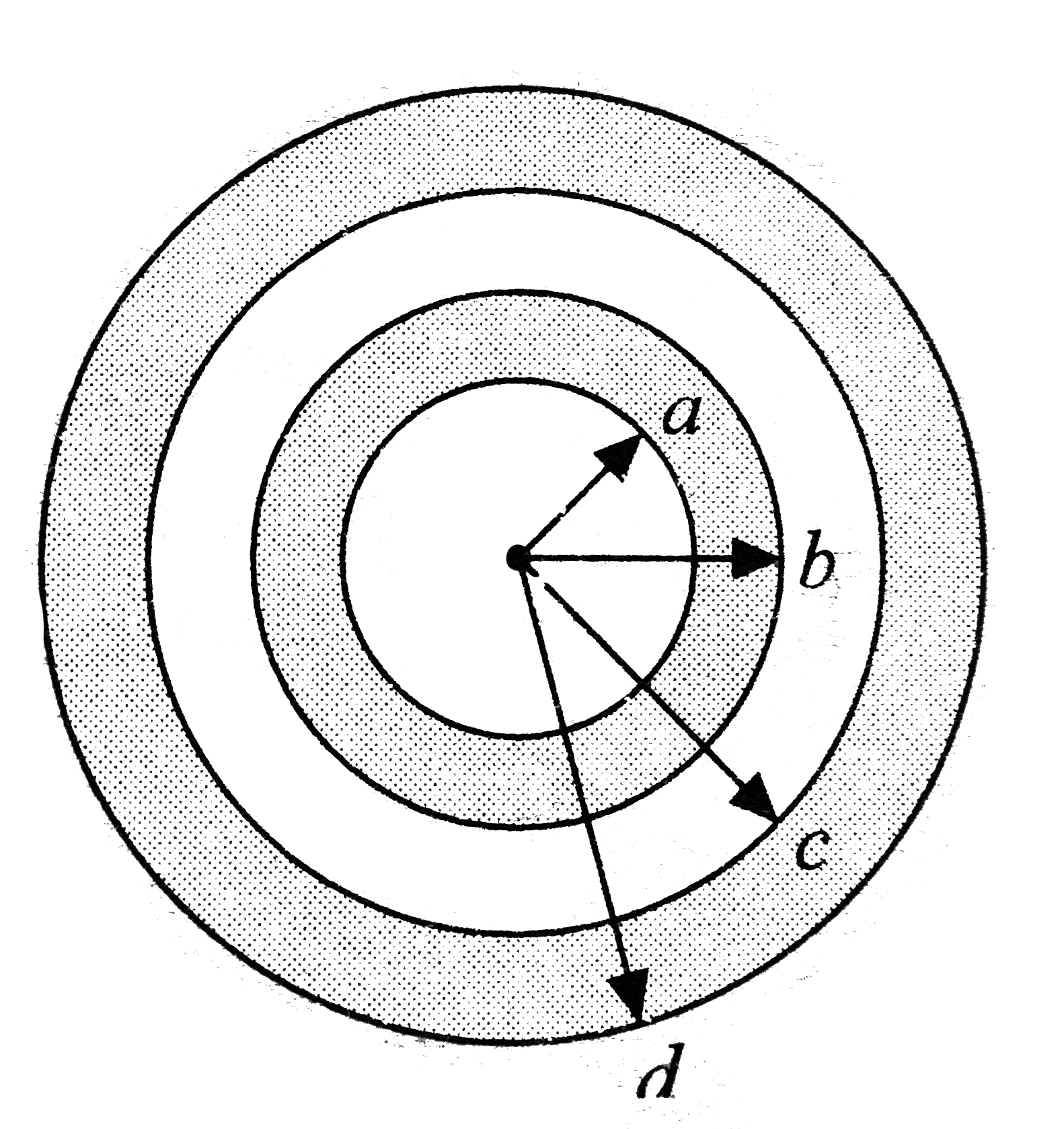
b<r<cAzeroB14πε02qr2C−14πε06qr2D14πε0qr2 - Question 3 - Select One
A small conducting spherical shell with inner radius a and outer radius b is concentric with a larger conducting spherical shell with inner radius c and outer radius d ( as shown in Fig . 2.121). The inner shell has a total charge +2q, and the outer shell has a total charge +4q. Calculate the electric field in terms of q and the distance r from the common center of the two shells for
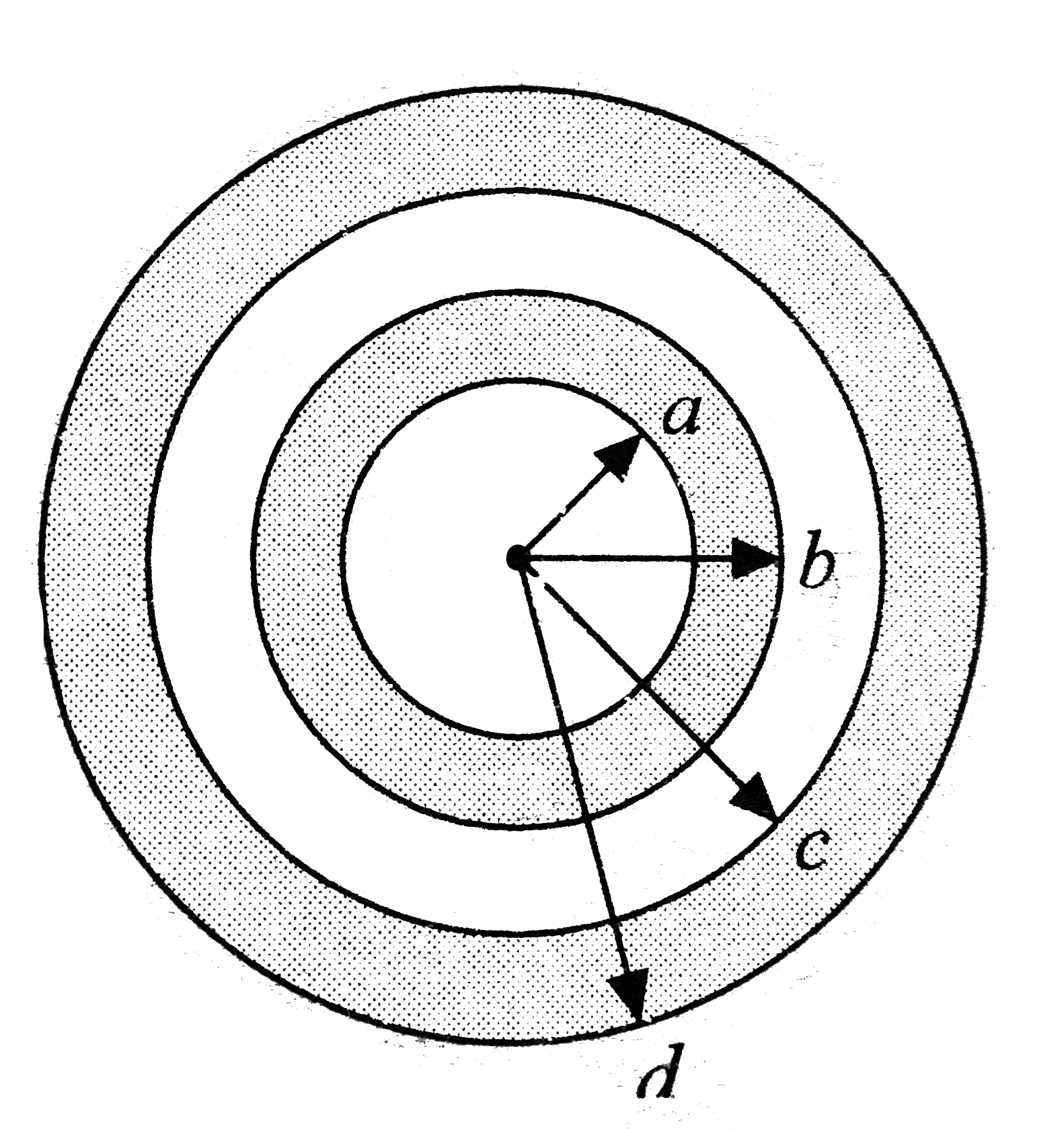
c<r<dAzeroB14πε02qr2C−14πε06qr2D14πε0qr2
Three conducting concentric spherical shells of radii R, 2R and 3R carry some charge on them. The potential at the centre is 50 V and that of middle and outer shell is 20 V and 10 V respectively. Find the potential of the inner Shell.
View SolutionA small conducting spherical shell with inner radius a and outer radius b is concentric with a larger conducting spherical shell with inner radius c and outer radius d ( as shown in Fig . 2.121). The inner shell has a total charge +2q, and the outer shell has a total charge +4q. Calculate the electric field in terms of q and the distance r from the common center of the two shells for

a<r<bView SolutionA small conducting spherical shell with inner radius a and outer radius b is concentric with a larger conducting spherical shell with inner radius c and outer radius d ( as shown in Fig . 2.121). The inner shell has a total charge +2q, and the outer shell has a total charge +4q. Calculate the electric field in terms of q and the distance r from the common center of the two shells for
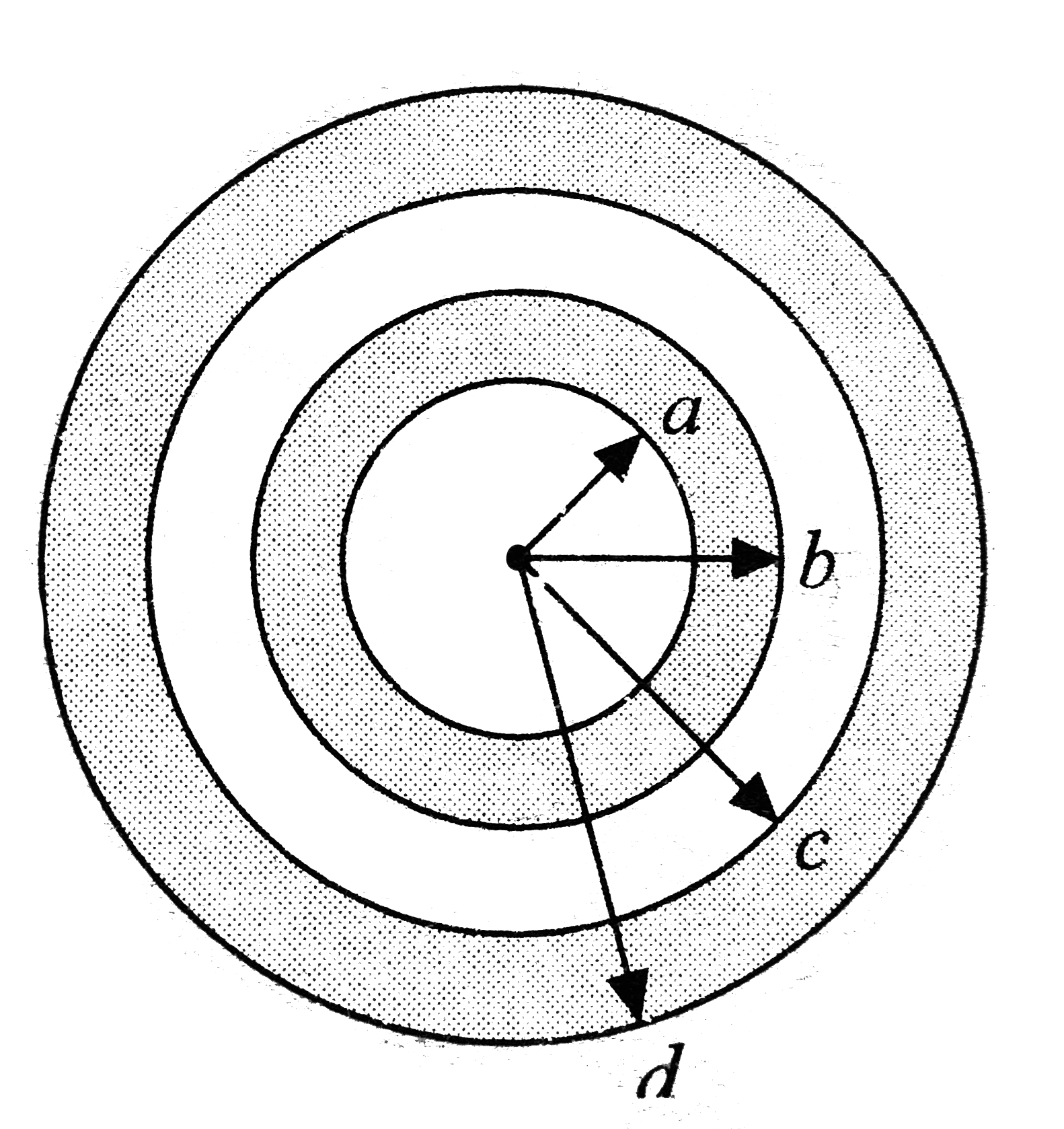
r<aView SolutionA small conducting spherical shell with inner radius a and outer radius b is concentric with a larger conducting spherical shell with inner radius c and outer radius d ( as shown in Fig . 2.121). The inner shell has a total charge +2q, and the outer shell has a total charge +4q. Calculate the electric field in terms of q and the distance r from the common center of the two shells for

r>dView SolutionA small conducting spherical shell with inner radius a and outer radius b is concentric with a larger conducting spherical shell with inner radius c and outer radius d ( as shown in Fig . 2.121). The inner shell has a total charge +2q, and the outer shell has a total charge +4q. Calculate the electric field in terms of q and the distance r from the common center of the two shells for
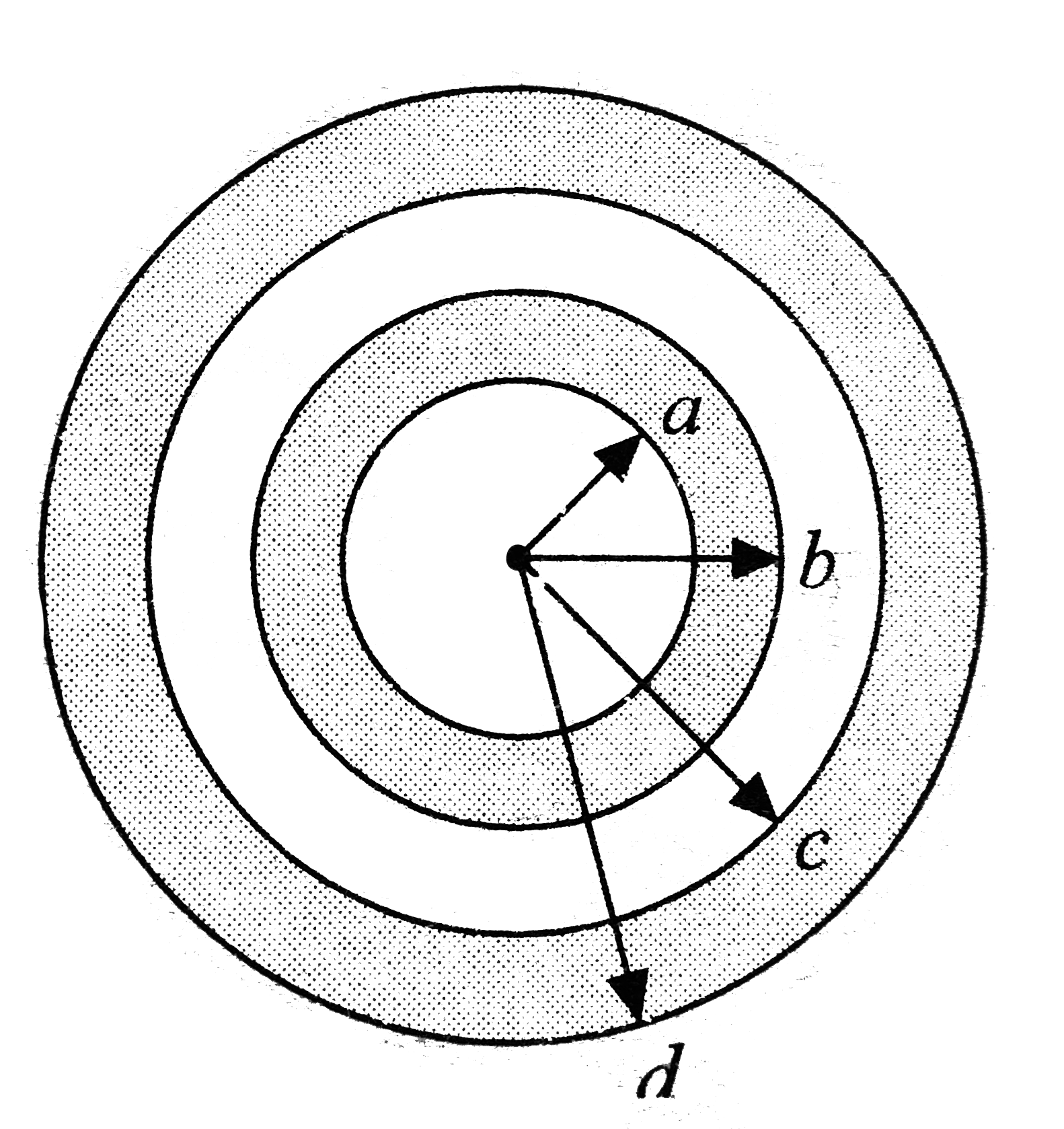
The graph of the radial component of E as a function of r will beView Solution

